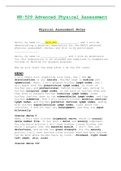Samenvatting
Samenvatting Molecular Biology of the Cell (5234MOBC6Y) - Master Biomedical Sciences ()
Uitgebreide samenvatting (Engels, 95 blz.) van alle hoorcolleges Molecular Biology of the Cell ter voorbereiding op het tentamen. Dit is het eerste vak van leerjaar 1 - Master Biomedical Sciences aan de UvA (verplicht vak voor alle tracks). Belangrijke concepten en begrippen zijn beschreven en geko...
[Meer zien]













